S
Σ sigma, capital letter; eighteenth letter in the Greek alphabet. A mathematical symbol for sum.
Sabouraud’s dextrose agar [sah-boo-ro′] see Sabouraud’s dextrose agar.
sabulous [sab′u-l s] gritty or sandy.
s] gritty or sandy.
saburra [s -bur′
-bur′ ] sordes; foulness of the mouth or stomach.
] sordes; foulness of the mouth or stomach.
saburral [s -bur′
-bur′ l] pertaining to saburra.
l] pertaining to saburra.
SAC Scottish Agricultural College.
sac [sak] a pouch; a baglike organ or structure. See also conjunctival sac.
endolymphatic s. the blind, flattened cerebral end of the endolymphatic duct.
hernial s. the peritoneal pouch that encloses a herniated viscus or mesentery.
pleural s. the pleura-lined cavity which contains the lung.
sacahuiste, sacahuista Nolina texana, N. microcarpa.
saccadic [s -kad′ik] characterized by saccades.
-kad′ik] characterized by saccades.
saccate [sak′āt] 1. shaped like a sac. 2. contained in a sac.
sacchariferous containing sugar.
saccharogalactorrhea secretion of milk containing an excess of sugar.
saccharogenic capable of producing a sugar.
saccharolytic [sak″ -ro-lit′ik] capable of splitting up sugar.
-ro-lit′ik] capable of splitting up sugar.
saccharometabolic [sak″ -ro-met″
-ro-met″ -bol′ik] pertaining to the metabolism of sugar.
-bol′ik] pertaining to the metabolism of sugar.
saccharometabolism [sak″ -ro-m
-ro-m -tab′o-liz-
-tab′o-liz- m] the metabolism of sugar.
m] the metabolism of sugar.
Saccharomyces farciminosum [sak″ -ro-mi′sēz] see Histoplasma capsulatum var farciminosum.
-ro-mi′sēz] see Histoplasma capsulatum var farciminosum.
Saccharomycopsis guttulatus [sak″ -ro-mi-kop′sis] see Cyniclomyces guttulatus.
-ro-mi-kop′sis] see Cyniclomyces guttulatus.
saccharum [sak′ -r
-r m] [L.] sugar (especially sucrose).
m] [L.] sugar (especially sucrose).
sacciform [sak′s -form] shaped like a bag or sac.
-form] shaped like a bag or sac.
Saccostrea glomerata farmed bivalve; called also Sydney rock oyster.
saccular [sak′u-l r] pertaining to or resembling a sac.
r] pertaining to or resembling a sac.
sacculated [sak′u-lāt″ d] containing saccules.
d] containing saccules.
large intestinal s. see haustrum.
sacculectomy surgical removal of saccular structures.
sacculitis [sak″u-li′tis] inflammation of a saccule, e.g. airsacculitis, anal sacculitis.
sacculus [sak′u-l s] pl. sacculi [L.] a saccule.
s] pl. sacculi [L.] a saccule.
s. laryngis see laryngeal saccule.
saccus [sak′ s] pl. sacci [L.] a sac.
s] pl. sacci [L.] a sac.
s. cecus the blind sac of a viscus such as the fundus of the stomach in the horse.
sacrad [sa′krad] toward the sacrum.
sacral [sa′kr l] pertaining to the sacrum.
l] pertaining to the sacrum.
s. dysgensis see sacrocaudal agenesis.
sacralgia [sa-kral′j ] pain in the sacrum.
] pain in the sacrum.
sacrectomy [sa-krek′t -me] excision or resection of the sacrum.
-me] excision or resection of the sacrum.
sacred bamboo see Nandina domestica.
Sacred cat of Burma see Birman.
sacr(o)- word element. [L.] sacrum.
sacrocaudal pertaining to the sacrum and the tail.
s. fusion an anomalous union between the sacrum and coccygeal vertebrae.
s. joint the joint between the sacrum and the tail.
sacrococcygeal [sa″kro-kok-sij′e- l] see sacrocaudal.
l] see sacrocaudal.
sacroiliitis [sa″kro-il″e-i′tis] inflammation of the sacroiliac joint.
sacrolumbar [sa″kro-lum′b r, -bahr] pertaining to the sacrum and lumbar vertebra; the loins.
r, -bahr] pertaining to the sacrum and lumbar vertebra; the loins.
sacropelvic [sa″kro-pel′vik] pertaining to the pelvis and sacrum.
sacrosciatic [sa″kro-si-at′ik] pertaining to the sacrum and ischium.
sacrospinal [sa″kro-spi′n l] pertaining to the sacrum and vertebral column.
l] pertaining to the sacrum and vertebral column.
sacrotuberous ligament [sa″kro-too′b r-
r- s] see Table 12.
s] see Table 12.
sacrouterine [sa″kro-u′t r-in] pertaining to the sacrum and uterus.
r-in] pertaining to the sacrum and uterus.
sacrovertebral [sa″kro-vur′t -br
-br l] pertaining to the sacrum and vertebrae.
l] pertaining to the sacrum and vertebrae.
sacrum [sa′kr m] the triangular-shaped bone between the lumbar and coccygeal vertebrae; formed usually of five fused vertebrae (four in pigs, three in dogs) that are wedged between the two hip bones. See also Tables 10.
m] the triangular-shaped bone between the lumbar and coccygeal vertebrae; formed usually of five fused vertebrae (four in pigs, three in dogs) that are wedged between the two hip bones. See also Tables 10.
SAD rabies vaccine Street–Alabama–Dufferin strain of attenuated rabies vaccine.
s. thrombus see saddle thrombus, aortic embolism.
s. scab see equine staphylococcal dermatitis.
Saddleback see Wessex saddleback.
saddlepatch disease see columnaris disease.
safety avoidance of occupational, iatrogenic or personal injury.
restraint s. proper use of appropriate restraint procedure when dealing with any animal.
saffron see Colchicum autumnale.
sage [sāj] common name for plants in the genus Salvia.
poison s. Isotropis atropurpurea.
s. sickness unspecified poisoning by Artemisia spp.
sagging crop see pendulous crop.
S. goat many varieties of this dual-purpose breed in North West Africa.
Sahiwal a reddish-dun zebu type breed of dairy cattle. Usually has white markings.
SAIDS simian acquired immune deficiency syndrome.
St. George disease see Pimelea.
St. Hubert hound see Bloodhound.
St. John’s wort see Hypericum.
St. Louis encephalitis see St. Louis encephalitis.
St. Lucia grass Brachiaria brizantha.
saki (Pithecia spp.) a small, longhaired, bushy-tailed, New World monkey.
salbutamol [sal-bu′t -mol] see albuterol.
-mol] see albuterol.
Salers mahogany red, dual-purpose French cattle.
salicylamide [sal″ -s
-s l-am′īd] an amide of salicylic acid; used as an analgesic; toxic in cats.
l-am′īd] an amide of salicylic acid; used as an analgesic; toxic in cats.
salicylazosulfapyridine [sal″ -sil-az″o-sul″f
-sil-az″o-sul″f -pir′
-pir′ -dēn] see sulfasalazine.
-dēn] see sulfasalazine.
salicylic acid [sal′ -sil′ik] o-hydroxybenzoic acid; used as a keratolytic. See also salicylate.
-sil′ik] o-hydroxybenzoic acid; used as a keratolytic. See also salicylate.
salicylism [sal′ -sil″iz-
-sil″iz- m] toxic signs caused by salicylic acid.
m] toxic signs caused by salicylic acid.
saline [sa′lēn, sa′līn] salty; of the nature of a salt.
hypertonic s. a solution contining 1–23.4% NaCl.
s. water poisoning see sodium chloride poisoning.
Whittingham’s s. a phosphate-buffered saline used to store fertilized embryos.
saliva [s -li′v
-li′v ] the enzyme-containing secretion of the salivary glands.
] the enzyme-containing secretion of the salivary glands.
salivant [sal′ -v
-v nt] causing flow of saliva.
nt] causing flow of saliva.
salivary [sal′ -var-e] pertaining to the saliva.
-var-e] pertaining to the saliva.
s. calculus sialolith. See salivary calculus.
s. duct dilatation see ranula.
s. ducts excretory ducts that carry the saliva from the glands to the mouth cavity.
s. g. inflammation see sialoadenitis, parotiditis.
salivation [sal″ -va′sh
-va′sh n] 1. the secretion of saliva. 2. ptyalism.
n] 1. the secretion of saliva. 2. ptyalism.
s. inhibitor antisialagogue; examples are atropine and glycopyrrolate.
salivon a functional salivary unit consisting of several acini and their related ducts and tubules.
Chinook s. Oncorhynchus tshawytscha.
s. louse Lepeophtherius salmonis.
pink s. Oncorhynchus gorbuscha.
sockeye s. Oncorhynchus nerka.
S. abortusequi causes abortion in horses.
S. abortusovis, S. montevideo cause abortion in sheep. A disease notifiable to the OIE (see Table 22).
S. bovismorbificans causes enteritis in cattle and horses.
S. dublin causes septicemia, meningitis, enteritis and abortion in cattle and abortion in sheep.
S. gallinarum causes fowl typhoid.
S. heidelberg an occasional isolate in horses.
S. pullorum causes pullorum disease.
S. typhisuis an uncommon isolate in pigs.
salmonid a member of the fish family Salmonidae. Includes salmon, trout, char.
salpingectomy [sal″pin-jek′t -me] excision of a uterine tube.
-me] excision of a uterine tube.
salpingemphraxis [sal″pin-j m-frak′sis] obstruction of a pharyngotympanic (eustachian) tube.
m-frak′sis] obstruction of a pharyngotympanic (eustachian) tube.
salpingian [sal-pin′je- n] pertaining to the auditory or the uterine tube.
n] pertaining to the auditory or the uterine tube.
parenchymatous s. pachysalpingitis.
salping(o)- word element. [Gr.] tube (eustachian tube or uterine tube).
salpingocele [sal-ping′go-sēl] hernial protrusion of a uterine tube.
salpingocyesis development of the embryo within a uterine tube; tubal pregnancy.
salpingolithiasis the presence of calcareous deposits in the wall of the uterine tubes.
salpingolysis [sal″ping-gol′ -sis] surgical separation of adhesions involving the uterine tubes.
-sis] surgical separation of adhesions involving the uterine tubes.
salpingo-oophorectomy [sal-ping″go-o-of″ -rek′t
-rek′t -me] excision of a uterine tube and ovary.
-me] excision of a uterine tube and ovary.
salpingo-oophoritis [sal-ping″go-o-of″ -ri′tis] inflammation of a uterine tube and ovary.
-ri′tis] inflammation of a uterine tube and ovary.
salpingo-oophorocele [sal-ping″go-o-of′ -ro-sēl] hernia of a uterine tube and ovary.
-ro-sēl] hernia of a uterine tube and ovary.
salpingopexy [sal-ping′go-pek″se] fixation of a uterine tube.
salpingopharyngeal [sal-ping″go-f -rin′je-
-rin′je- l] pertaining to the auditory tube and the pharynx.
l] pertaining to the auditory tube and the pharynx.
salpingoplasty [sal-ping′go-plas″te] plastic repair of a uterine tube.
salpingotomy [sal″ping-got′ -me] surgical incision of a uterine tube.
-me] surgical incision of a uterine tube.
salpinx [sal′pinks] 1. a uterine tube. 2. an auditory tube.
SALT see skin-associated lymphoid tissues.
common s. see sodium chloride.
Rochelle s. potassium sodium tartrate, a cathartic.
s. sick see copper nutritional deficiency.
smelling s’s aromatic ammonium carbonate, a stimulant and restorative.
salt sickness dual copper and cobalt deficiency.
saltatory [sal′t -tor″e] pertaining to or emanating from saltation.
-tor″e] pertaining to or emanating from saltation.
barrier s. see Enchylaena tomentosa.
four wing s. Atriplex canescens.
ruby s. see Enchylaena tomentosa.
Salter–Harris classification see Salter classification.
saltpeter, saltpetre potassium nitrate.
salubrious [s -loo′bre-
-loo′bre- s] conducive to health; wholesome.
s] conducive to health; wholesome.
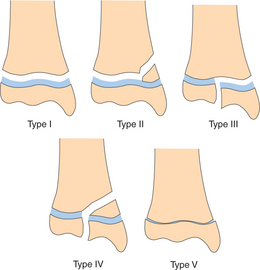
S-8 : Salter-Harris classification of physeal fractures.
From Fossum TW, Small Animal Surgery, 3rd Edition. Mosby, 2007.
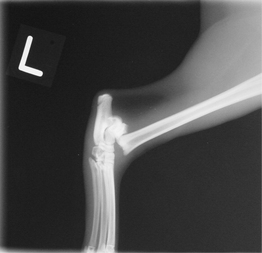
S-9 : Salter I fracture of the distal tibia in a cat.
From Seaman JA, Simpson AM: Tibial fractures. Clin Tech Sm Anim Pract 19:151-167, 2004. Elsevier.
saluresis [sal″u-re′sis] excretion of sodium and chloride in the urine.
saluretic [sal″u-ret′ik] 1. pertaining to saluresis. 2. an agent that promotes saluresis.
salutary [sal′u-tar″e] healthful.
salvage statistics [sal′v j] see salvage statistics.
j] see salvage statistics.
Salvation Jane Echium plantagineum.
Salvia [sal′ve- ] a genus of the plant family Lamiaceae.
] a genus of the plant family Lamiaceae.
samarium (Sm) [s -mar′e-
-mar′e- m] a chemical element, atomic number 62, atomic weight 150.35. See Table 4.
m] a chemical element, atomic number 62, atomic weight 150.35. See Table 4.
samore trypanosomiasis; called also nagana.
EPSEM s. acronym for ‘equal opportunity of selection method’.
simple random s. see random sample (above).
sampling [sam′pling] the process of selecting a sample.
area s. dividing the population into equal areas and randomly selecting from among the areas.
s. fraction ratio of the number of units in the population to the number of units in the population.
San Joaquin Valley fever the primary form of coccidioidomycosis.
sanatory [san′ -tor″e] salubrious.
-tor″e] salubrious.
Sancassania berlessei a mite of stored products occasionally infests sheep.
sand twin leaf Zygophyllum ammophilum.
sandbath, sand roll a stall covered with deep sand used for horses to roll in after exercise.
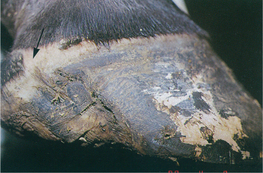
S-11 : Sandcrack in horse’s hoof.
From Knottenbelt DC, Pascoe RR, Diseases and Disorders of the Horse. Saunders, 2003.
 n] a test which detects serum antibody against Toxoplasma gondii. In the presence of antibodies, live organisms are not stained with methylene blue. Called also methylene blue dye binding test.
n] a test which detects serum antibody against Toxoplasma gondii. In the presence of antibodies, live organisms are not stained with methylene blue. Called also methylene blue dye binding test. -kād′] small, rapid, involuntary, jerky movements of both eyes simultaneously, such as occur in humans while reading and all animals when focusing attention on a fixed object during head movements.
-kād′] small, rapid, involuntary, jerky movements of both eyes simultaneously, such as occur in humans while reading and all animals when focusing attention on a fixed object during head movements. -rīd] one of a series of carbohydrates, including the sugars; they are divided into monosaccharides, disaccharides, trisaccharides and polysaccharides according to the number of saccharide groups present.
-rīd] one of a series of carbohydrates, including the sugars; they are divided into monosaccharides, disaccharides, trisaccharides and polysaccharides according to the number of saccharide groups present. n] 1. a saccule, or pouch. 2. the quality of being sacculated. 3. the formation of pouches.
n] 1. a saccule, or pouch. 2. the quality of being sacculated. 3. the formation of pouches.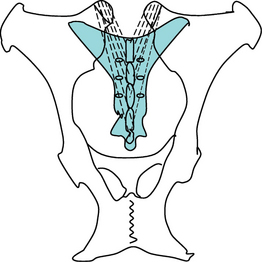
 l-
l- -za′sh
-za′sh n] anomalous fusion of the last lumbar vertebra with the first segment of the sacrum.
n] anomalous fusion of the last lumbar vertebra with the first segment of the sacrum. l] 1. the back region over the thoracic vertebrae. 2. a coat color marking in dogs, usually black, located over the back. Seen in Beagles. 3. a piece of harness for either riding or draft.
l] 1. the back region over the thoracic vertebrae. 2. a coat color marking in dogs, usually black, located over the back. Seen in Beagles. 3. a piece of harness for either riding or draft.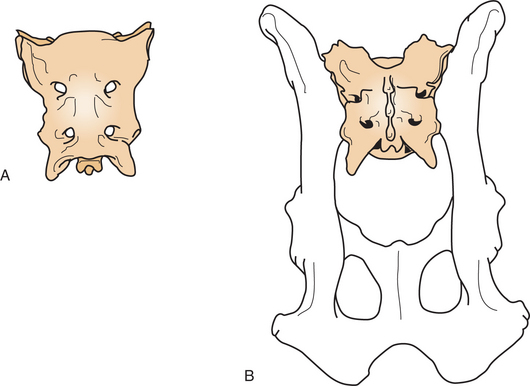
 r] ground cake made of decorticated residue of seeds of Carthamus tinctorius, rich in linoleic acid. A modest protein dietary supplement deficient in methionine and lysine. Called also kurdee.
r] ground cake made of decorticated residue of seeds of Carthamus tinctorius, rich in linoleic acid. A modest protein dietary supplement deficient in methionine and lysine. Called also kurdee. -t
-t l] 1. shaped like an arrow. 2. situated in the direction of the sagittal suture; said of a plane or section parallel to the median plane of the body.
l] 1. shaped like an arrow. 2. situated in the direction of the sagittal suture; said of a plane or section parallel to the median plane of the body. -man′d
-man′d r] lizard-like amphibians in the order Caudata; they may be aquatic, semi-aquatic or terrestial, often depending on their life stage. They are capable of regenerating lost body parts, and in order to escape predators will shed their tail, which later regrows. Neoteny, the maintenance of larval characteristics throughout life, is a common phenomenon in these animals. Popular as pets. See also newts.
r] lizard-like amphibians in the order Caudata; they may be aquatic, semi-aquatic or terrestial, often depending on their life stage. They are capable of regenerating lost body parts, and in order to escape predators will shed their tail, which later regrows. Neoteny, the maintenance of larval characteristics throughout life, is a common phenomenon in these animals. Popular as pets. See also newts. -s
-s l-s
l-s l-fon’ik] precipitation of protein in a urine sample by a 20% aqueous solution of salicyl-sulfonic acid. Placing the urine over a layer of reagent in a test tube results in the formation of a white ring where the two solutions meet, indicating that protein is present.
l-fon’ik] precipitation of protein in a urine sample by a 20% aqueous solution of salicyl-sulfonic acid. Placing the urine over a layer of reagent in a test tube results in the formation of a white ring where the two solutions meet, indicating that protein is present. -s
-s l-an’
l-an’ -līd] a group of anthelmintics which exert their action by uncoupling mitochondrial reactions which are critical to electron transport and associated phosphorylation in the metabolic system of the parasite. Bind to plasma proteins and persist for several weeks. They are effective against cestodes and trematodes but generally not nematodes. Some are active against Haemonchus contortus, e.g. rafoxanide and closantel.
-līd] a group of anthelmintics which exert their action by uncoupling mitochondrial reactions which are critical to electron transport and associated phosphorylation in the metabolic system of the parasite. Bind to plasma proteins and persist for several weeks. They are effective against cestodes and trematodes but generally not nematodes. Some are active against Haemonchus contortus, e.g. rafoxanide and closantel. -sil′āt, s
-sil′āt, s -lis′
-lis′ -lāt] any salt or ester of salicylic acid. The salicylates used as drugs for their analgesic, antipyretic and anti-inflammatory effects include aspirin (acetylsalicylic acid, ASA), methyl salicylate and sodium salicylate. Low dosages of salicylates are used primarily for the relief of mild-to-moderate pain or fever. The mechanism of most of the effects of aspirin and other salicylates is inhibition of prostaglandin synthesis, thus blocking pyretic and inflammatory processes that are mediated by prostaglandins. Aspirin also prolongs the bleeding time through its effects on platelets owing to both inhibition of prostaglandin synthesis and acetylation of platelet structures. Salicylates also cause ulceration and hemorrhagic lesions of the gastric mucosa; the same mechanisms involved in the anti-inflammatory effects increase the production of stomach acid, decrease the secretion of protective mucus and increase bleeding. See also aspirin poisoning.
-lāt] any salt or ester of salicylic acid. The salicylates used as drugs for their analgesic, antipyretic and anti-inflammatory effects include aspirin (acetylsalicylic acid, ASA), methyl salicylate and sodium salicylate. Low dosages of salicylates are used primarily for the relief of mild-to-moderate pain or fever. The mechanism of most of the effects of aspirin and other salicylates is inhibition of prostaglandin synthesis, thus blocking pyretic and inflammatory processes that are mediated by prostaglandins. Aspirin also prolongs the bleeding time through its effects on platelets owing to both inhibition of prostaglandin synthesis and acetylation of platelet structures. Salicylates also cause ulceration and hemorrhagic lesions of the gastric mucosa; the same mechanisms involved in the anti-inflammatory effects increase the production of stomach acid, decrease the secretion of protective mucus and increase bleeding. See also aspirin poisoning.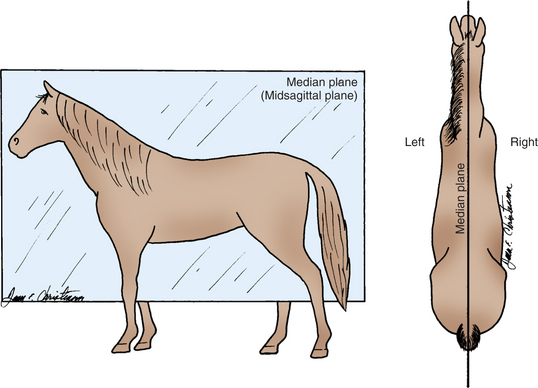
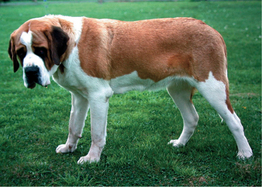
 -var’e-
-var’e- ] the anterior station group of trypanosomes which transmit the protozoa with their mouthparts.
] the anterior station group of trypanosomes which transmit the protozoa with their mouthparts. -var′e-
-var′e- n] said of trypanosomes, such as Duttonella, Nannomonas, Pycnomonas and Trypanosoma. These trypanosomes are passed to the recipient in the saliva of the tsetse fly (Glossina spp.). See also Salivaria.
n] said of trypanosomes, such as Duttonella, Nannomonas, Pycnomonas and Trypanosoma. These trypanosomes are passed to the recipient in the saliva of the tsetse fly (Glossina spp.). See also Salivaria.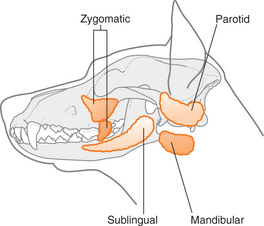
 -var-e] any of the glands around the mouth that secrete saliva. The major ones are the three pairs known as the parotid, mandibular or submandibular and sublingual glands. There are other smaller salivary glands within the cheeks, e.g. zygomatic gland, and in the tongue.
-var-e] any of the glands around the mouth that secrete saliva. The major ones are the three pairs known as the parotid, mandibular or submandibular and sublingual glands. There are other smaller salivary glands within the cheeks, e.g. zygomatic gland, and in the tongue. r-ol] a long-acting β2-agonist used in inhalation therapy for inflammatory airway disease.
r-ol] a long-acting β2-agonist used in inhalation therapy for inflammatory airway disease. ] a genus of gram-negative, non-lactose fermenting, medium-sized, rod-shaped, bacteria, members of the family Enterobacteriaceae, most species having flagella and pili. The genus contains three species which have been divided into seven subgroups and a very large number of serotypes. Most species pathogenic for warm-blooded animals are in subgroup I (S. enterica). Subgroups IIIa (S. salamae) and IIIb (S. arizonae) include some species occasionally pathogenic for animals and birds. The salmonella include the typhoid–paratyphoid bacilli and bacteria usually pathogenic for lower animals but which are often transmitted to humans. They cause salmonellosis which has a number of manifestations and some are specific causes of abortion. Although serotypes are not recognized as species, the serotype names are often written as though they are species names.
] a genus of gram-negative, non-lactose fermenting, medium-sized, rod-shaped, bacteria, members of the family Enterobacteriaceae, most species having flagella and pili. The genus contains three species which have been divided into seven subgroups and a very large number of serotypes. Most species pathogenic for warm-blooded animals are in subgroup I (S. enterica). Subgroups IIIa (S. salamae) and IIIb (S. arizonae) include some species occasionally pathogenic for animals and birds. The salmonella include the typhoid–paratyphoid bacilli and bacteria usually pathogenic for lower animals but which are often transmitted to humans. They cause salmonellosis which has a number of manifestations and some are specific causes of abortion. Although serotypes are not recognized as species, the serotype names are often written as though they are species names. l-o′sis] a highly contagious disease of all animal species caused by Salmonella. Salmonella serovars differ in the range of hosts they can infect and in the nature of disease that may result. Some can infect a wide range of hosts and are termed ubiquitous, others are very restricted in their host range, causing severe disease in only one host. Depending on the serovar and host, salmonellosis may be manifest by septicemia, and acute or chronic enteritis. Abortion is a common accompaniment, particularly in food animals and horses. Localization may occur in almost any organ. It is a rare occurrence in companion animals. Called also paratyphoid. Certain serovars are transmissible to humans and salmonellosis is an important zoonosis, with special implications for veterinarians involved in food hygiene.
l-o′sis] a highly contagious disease of all animal species caused by Salmonella. Salmonella serovars differ in the range of hosts they can infect and in the nature of disease that may result. Some can infect a wide range of hosts and are termed ubiquitous, others are very restricted in their host range, causing severe disease in only one host. Depending on the serovar and host, salmonellosis may be manifest by septicemia, and acute or chronic enteritis. Abortion is a common accompaniment, particularly in food animals and horses. Localization may occur in almost any organ. It is a rare occurrence in companion animals. Called also paratyphoid. Certain serovars are transmissible to humans and salmonellosis is an important zoonosis, with special implications for veterinarians involved in food hygiene.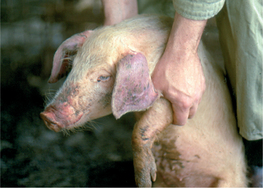
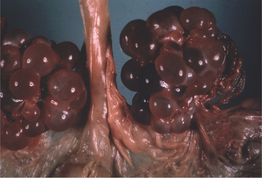
 -fe] radiography of the uterine tubes after intrauterine injection of a radiopaque medium.
-fe] radiography of the uterine tubes after intrauterine injection of a radiopaque medium. -me] 1. formation of an opening or fistula into a uterine tube for the purpose of drainage. 2. surgical restoration of the patency of a uterine tube.
-me] 1. formation of an opening or fistula into a uterine tube for the purpose of drainage. 2. surgical restoration of the patency of a uterine tube. n] 1. the action of leaping, as in louping ill or the dancing of porcine myotonia congenita. 2. conduction along myelinated nerves. 3. in genetics, an abrupt variation in species; a mutation.
n] 1. the action of leaping, as in louping ill or the dancing of porcine myotonia congenita. 2. conduction along myelinated nerves. 3. in genetics, an abrupt variation in species; a mutation. r] a system for classifying fractures, fracture- separations, and separations of the physis into five types. They are: Salter type I—a separation line through the epiphyseal plate only; Salter type II—a partial separation of the epiphyseal plate and fracture into the metaphyseal bone; Salter type III—a partial separation of the epiphyseal plate and a fracture through the epiphysis; Salter type IV—a fracture through the metaphysis, across the epiphyseal plate and through the epiphysis; Salter type V—a crushing or compression injury to the epiphyseal plate. Called also Salter–Harris classification.
r] a system for classifying fractures, fracture- separations, and separations of the physis into five types. They are: Salter type I—a separation line through the epiphyseal plate only; Salter type II—a partial separation of the epiphyseal plate and fracture into the metaphyseal bone; Salter type III—a partial separation of the epiphyseal plate and a fracture through the epiphysis; Salter type IV—a fracture through the metaphysis, across the epiphyseal plate and through the epiphysis; Salter type V—a crushing or compression injury to the epiphyseal plate. Called also Salter–Harris classification.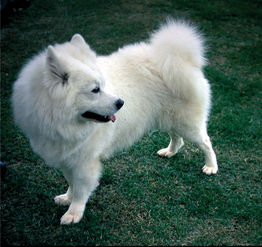
 l] 1. a specimen of fluid, blood or tissue collected for analysis on the assumption that it represents the composition of the whole. 2. for statistical purposes a small collection of individual units taken from the population which is under investigation on the assumption that they represent the characteristics of the entire population.
l] 1. a specimen of fluid, blood or tissue collected for analysis on the assumption that it represents the composition of the whole. 2. for statistical purposes a small collection of individual units taken from the population which is under investigation on the assumption that they represent the characteristics of the entire population. -tiv] curative; healing. Said of trypanocidal drugs used between long courses of more popular drugs in order to avoid the development of resistance to those drugs by the trypanosomes.
-tiv] curative; healing. Said of trypanocidal drugs used between long courses of more popular drugs in order to avoid the development of resistance to those drugs by the trypanosomes.


